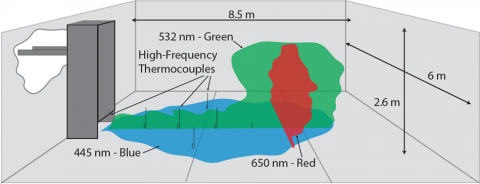Currents are generated by loading a known mass of 20-micron talc onto a conveyor. The conveyor feeds the talk at a known rate into a chute. A portion of the talc falling down the chute forms a turbulent density current that enters the experimental "tank" (8.5 x 6.5 x 2.5 m enclosure). The current mass is determined by subtracting the mass of particles at the base of the chute from the initial mass loaded onto the conveyor. Heated currents, for study of pyroclastic density currents, can be generated by loading the conveyor belt with heated particles.
Experiments are visualized with laser illumination, and temperature is monitored with an array of 30 high-frequency thermocouples. Laser illumination consists of red, green, and blue sheets, that can be positioned independently; the laser sheet wavelengths correspond to peak sensitivities of the CMOS sensors in DSLR and HD video cameras, thus video files can be separated into red, green, or blue channels, each of which only observes the sheet of interest. Laser illumination also includes a blue laser sheet(the "Disco Laser") that sweeps the tank at a rate of ~10 Hz; a high-speed IDT Y3-S2 camera records experiments illuminated with the Disco Laser for 3D reconstructions with 1 cm resolution of the camera every 0.5 seconds.
